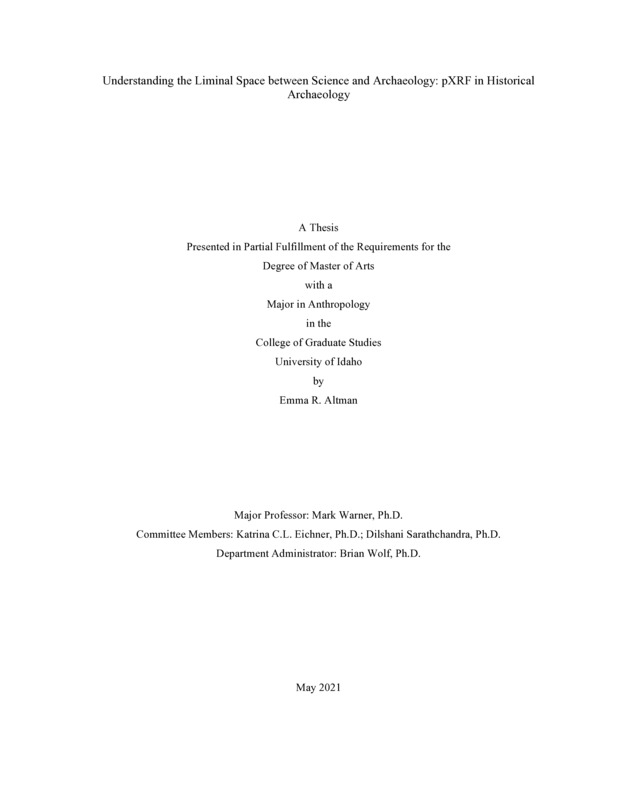Understanding the Liminal Space between Science and Archaeology: pXRF in Historical Archaeology
Altman, Emma Ruth. (2021-05). Understanding the Liminal Space between Science and Archaeology: pXRF in Historical Archaeology. Theses and Dissertations Collection, University of Idaho Library Digital Collections. https://www.lib.uidaho.edu/digital/etd/items/altman_idaho_0089n_12073.html
- Title:
- Understanding the Liminal Space between Science and Archaeology: pXRF in Historical Archaeology
- Author:
- Altman, Emma Ruth
- ORCID:
- 0000-0001-8658-2475
- Date:
- 2021-05
- Keywords:
- archaeology historical archaeology pXRF science in archaeology x-ray fluorescence
- Program:
- Anthropology
- Subject Category:
- Cultural anthropology; Physical anthropology; Philosophy of science
- Abstract:
-
There exists a shared space where archaeologists use techniques developed by scientists to explore archaeological questions. Portable x-ray fluorescence spectrometry (pXRF) is one such technique where archaeologists are uncovering appropriate archaeological applications. However, pXRF is currently used mainly by prehistoric archaeologists examining obsidian artifacts and is only used sparingly by historical archaeologists. This thesis sets out to explore the liminal space between science and archaeology through a case study of the use (or lack thereof) of pXRF in historical archaeological contexts. This mixed-methods qualitative study has three parts: (1) an examination of the history of the relationship between archaeology and science, (2) semi-structured interviews with eight historical archaeologists and two representatives of manufacturers experiences with pXRF, and (3) a scoping literature review of published historical archaeological research in the last two decades.
Data suggest that historical archaeologists are negotiating inclusion of their work into the boundary of ‘science’; meaningful, varied, and successful research is currently being conducted, but there are negative feedback loops that prevent wider usage. Although participants spoke with enthusiasm about their own work and future applications of pXRF in historical archaeology, they described barriers with training, lack of published methodologies, and a generally negative climate surrounding historical archaeological applications of pXRF, which is reflected in the lack of peer-reviewed published literature discovered in the scoping review. However, this study suggests that pXRF is useful tool, with limitations, that, with further research, has the ability to be applied appropriately in more historical contexts to answer interesting and novel archaeological questions. However, determining ‘appropriateness’ of various applications depends entirely on (re)negotation of the boundaries between archaeology and science, which is mediated by the complicated historic relationship between the fields.
- Description:
- masters, M.A., Anthropology -- University of Idaho - College of Graduate Studies, 2021-05
- Major Professor:
- Warner, Mark
- Committee:
- Sarathchandra, Dilshani; Eichner, Katrina C.L.
- Defense Date:
- 2021-05
- Identifier:
- Altman_idaho_0089N_12073
- Type:
- Text
- Format Original:
- Format:
- application/pdf
- Rights:
- In Copyright - Educational Use Permitted. For more information, please contact University of Idaho Library Special Collections and Archives Department at libspec@uidaho.edu.
- Standardized Rights:
- http://rightsstatements.org/vocab/InC-EDU/1.0/

